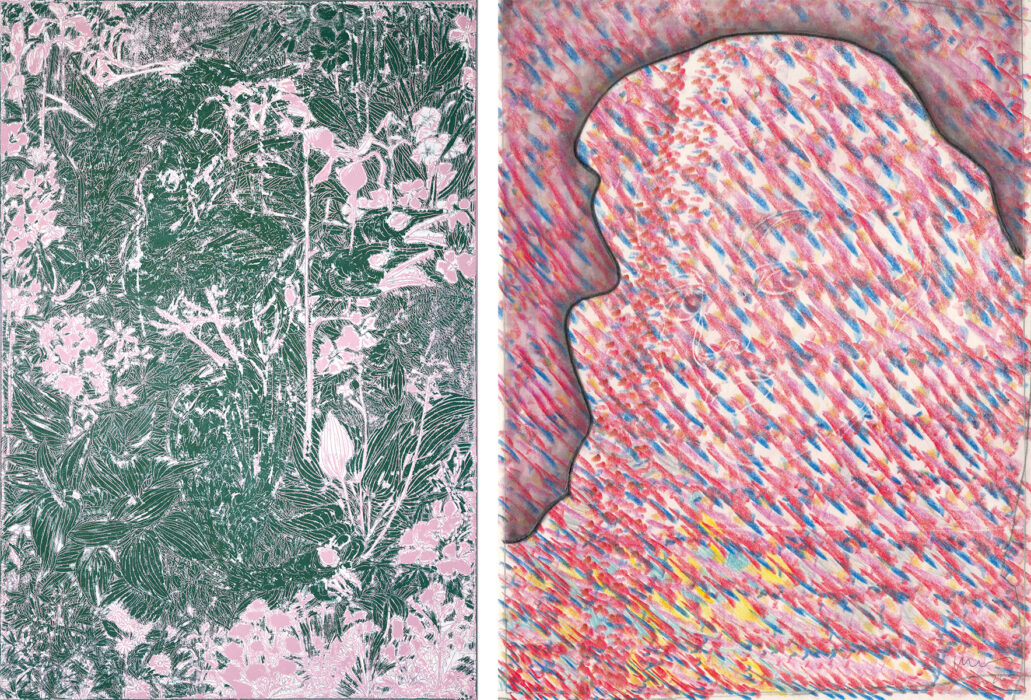In the duo show “Curvy Coast”, the works on paper and canvas by Sascha Brylla and Robert Kraiss bring together positions that operate with independent, elaborate methods of surface treatment of image and image carrier.
In Sascha Brylla’s work, colours are first applied in several, mostly monochrome, overlapping layers of egg tempera. In the subsequent process of removal, the motif is carefully worked out of the surface, out of the layers of colour: Fine, linear depressions are created across the entire surface of the painting, which are scratched out of the layers of paint at different levels. In places, larger areas of colour are also successively removed.
In his complex pictorial structures, motivic contents are subtly interwoven with an ornamental all-over of floral elements. The motif does not push forward. Rather, for Sascha Brylla it functions as an occasion to observe its disappearance, its gradual dissolution in the process of creation.
In his more recent works, sharply outlined colour ridges stand next to diffusely frayed colour fields. This creates an aesthetic effect reminiscent of worn garments and early tapestries.
In an experimental approach to drawing, Robert Kraiss employs distancing and technification methods that aim to neutralise (or at least discuss) the appearance of individuality, gesture and expression implicit in the medium of drawing. Among other things, he uses drilling machines and wire brushes to apply colour with pencils and later erase individual sections. In this sometimes destructive act, strikingly delicate, velvety and tactile surfaces emerge – almost contradictorily.
The disparate pictorial objects – such as superheroes, art-historical paraphrases, erotic depictions or disguised self-portraits – derive their aesthetic radiance, asserted as equal, from the chosen mode of representation. The motif is extended into the surface and docks onto the emphasised uniformity of full-surface, multi-coloured structures. In its intensity, the impression of the paper surface undermines the seemingly carelessly chosen content. Surface and superficiality become the overriding theme.
Both, very different artistic methods result in a dissolution of the motif in the surface. Robert Kraiss’ fast, vibrating and – especially in large format – power-sapping technique produces drawings that are close to the dissolution of form in Impressionism. And in a careful, filigree process, Sascha Brylla creates an all-over that evokes associations with textile surface structures. In their choice of subject matter, both positions move between ironic distance and deliberate apparent naivety of the motif.
With kind support of: Ministerium für Bildung, Kultur und Wissenschaft, Landeshaupstadt Schwerin, and Stiftung für Ehrenamt und bürgerschaftliches Engagement in Mecklenburg-Vorpommern.


In the duo show “Curvy Coast”, the works on paper and canvas by Sascha Brylla and Robert Kraiss bring together positions that operate with independent, elaborate methods of surface treatment of image and image carrier.
In Sascha Brylla’s work, colours are first applied in several, mostly monochrome, overlapping layers of egg tempera. In the subsequent process of removal, the motif is carefully worked out of the surface, out of the layers of colour: Fine, linear depressions are created across the entire surface of the painting, which are scratched out of the layers of paint at different levels. In places, larger areas of colour are also successively removed.
In his complex pictorial structures, motivic contents are subtly interwoven with an ornamental all-over of floral elements. The motif does not push forward. Rather, for Sascha Brylla it functions as an occasion to observe its disappearance, its gradual dissolution in the process of creation.
In his more recent works, sharply outlined colour ridges stand next to diffusely frayed colour fields. This creates an aesthetic effect reminiscent of worn garments and early tapestries.
In an experimental approach to drawing, Robert Kraiss employs distancing and technification methods that aim to neutralise (or at least discuss) the appearance of individuality, gesture and expression implicit in the medium of drawing. Among other things, he uses drilling machines and wire brushes to apply colour with pencils and later erase individual sections. In this sometimes destructive act, strikingly delicate, velvety and tactile surfaces emerge – almost contradictorily.
The disparate pictorial objects – such as superheroes, art-historical paraphrases, erotic depictions or disguised self-portraits – derive their aesthetic radiance, asserted as equal, from the chosen mode of representation. The motif is extended into the surface and docks onto the emphasised uniformity of full-surface, multi-coloured structures. In its intensity, the impression of the paper surface undermines the seemingly carelessly chosen content. Surface and superficiality become the overriding theme.
Both, very different artistic methods result in a dissolution of the motif in the surface. Robert Kraiss’ fast, vibrating and – especially in large format – power-sapping technique produces drawings that are close to the dissolution of form in Impressionism. And in a careful, filigree process, Sascha Brylla creates an all-over that evokes associations with textile surface structures. In their choice of subject matter, both positions move between ironic distance and deliberate apparent naivety of the motif.
With kind support of: Ministerium für Bildung, Kultur und Wissenschaft, Landeshaupstadt Schwerin, and Stiftung für Ehrenamt und bürgerschaftliches Engagement in Mecklenburg-Vorpommern.